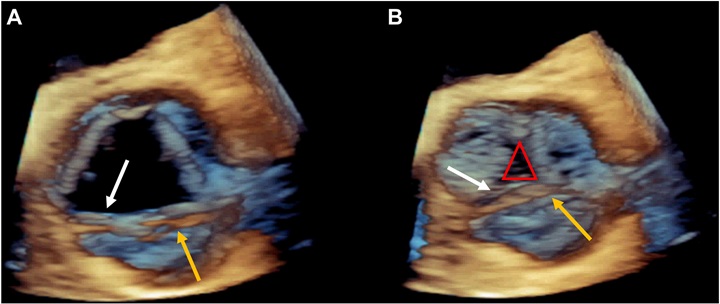 The latest issue of CASE is now available with intriguing reports, including “Use of Three-Dimensional Echocardiography to Identify an Unusual Cause of Aortic Regurgitation” by Buck et al. CASE Editor-in-Chief Vincent Sorrell, MD, FASE, remarked, “The authors have provided readers with an impactful CASE report that discusses an unusual cause of AR that was discovered with 3D TEE. Their patient had a new diastolic murmur and reduced diastolic BP after a recent invasive coronary angiogram with PCI performed 10 days earlier. TTE demonstrated significant AR and a small linear mass on the AV. Despite an initial suspicion for infective endocarditis, blood cultures remained negative and deductive reasoning raised the concern for an iatrogenic injury to the AV. The 3D TEE demonstrated a band of tissue on the edge of the right coronary cusp. This finding correlated beautifully to an intraoperative photograph and confirms the mechanism of the AR to be due to iatrogenic, partial detachment of the AV cusp. One of the great strengths of CASE is how it serves to help build your imaging knowledge base with these types of surgical and pathologic direct comparisons.”
The latest issue of CASE is now available with intriguing reports, including “Use of Three-Dimensional Echocardiography to Identify an Unusual Cause of Aortic Regurgitation” by Buck et al. CASE Editor-in-Chief Vincent Sorrell, MD, FASE, remarked, “The authors have provided readers with an impactful CASE report that discusses an unusual cause of AR that was discovered with 3D TEE. Their patient had a new diastolic murmur and reduced diastolic BP after a recent invasive coronary angiogram with PCI performed 10 days earlier. TTE demonstrated significant AR and a small linear mass on the AV. Despite an initial suspicion for infective endocarditis, blood cultures remained negative and deductive reasoning raised the concern for an iatrogenic injury to the AV. The 3D TEE demonstrated a band of tissue on the edge of the right coronary cusp. This finding correlated beautifully to an intraoperative photograph and confirms the mechanism of the AR to be due to iatrogenic, partial detachment of the AV cusp. One of the great strengths of CASE is how it serves to help build your imaging knowledge base with these types of surgical and pathologic direct comparisons.”
In addition to that report, this issue presents two other cases in the Valvular Heart Disease category: rheumatic heart disease as an atypical cause of severe aortic stenosis and a rare acquired Gerbode-type shunt from endocarditis. Rare But Deadly Findings displays an accidental discovery of a mushroom-shaped RVOT as an early hint of pediatric arrhythmogenic right ventricular cardiomyopathy (ARVC), as well as a report on type A aortic dissection that emphasizes the importance of a rapid diagnosis through multimodality imaging. Read up on Dr. Sorrell’s editorial as he uncovers the historical evolution of echo and how today’s serendipitous findings in the lab continue to move the practice of echo forward.
Looking for a journal to submit your case report to? We want to hear from you! Email us with questions or submit your report today.
Publish date
May 21, 2024
Topic
- CASE
Related News



